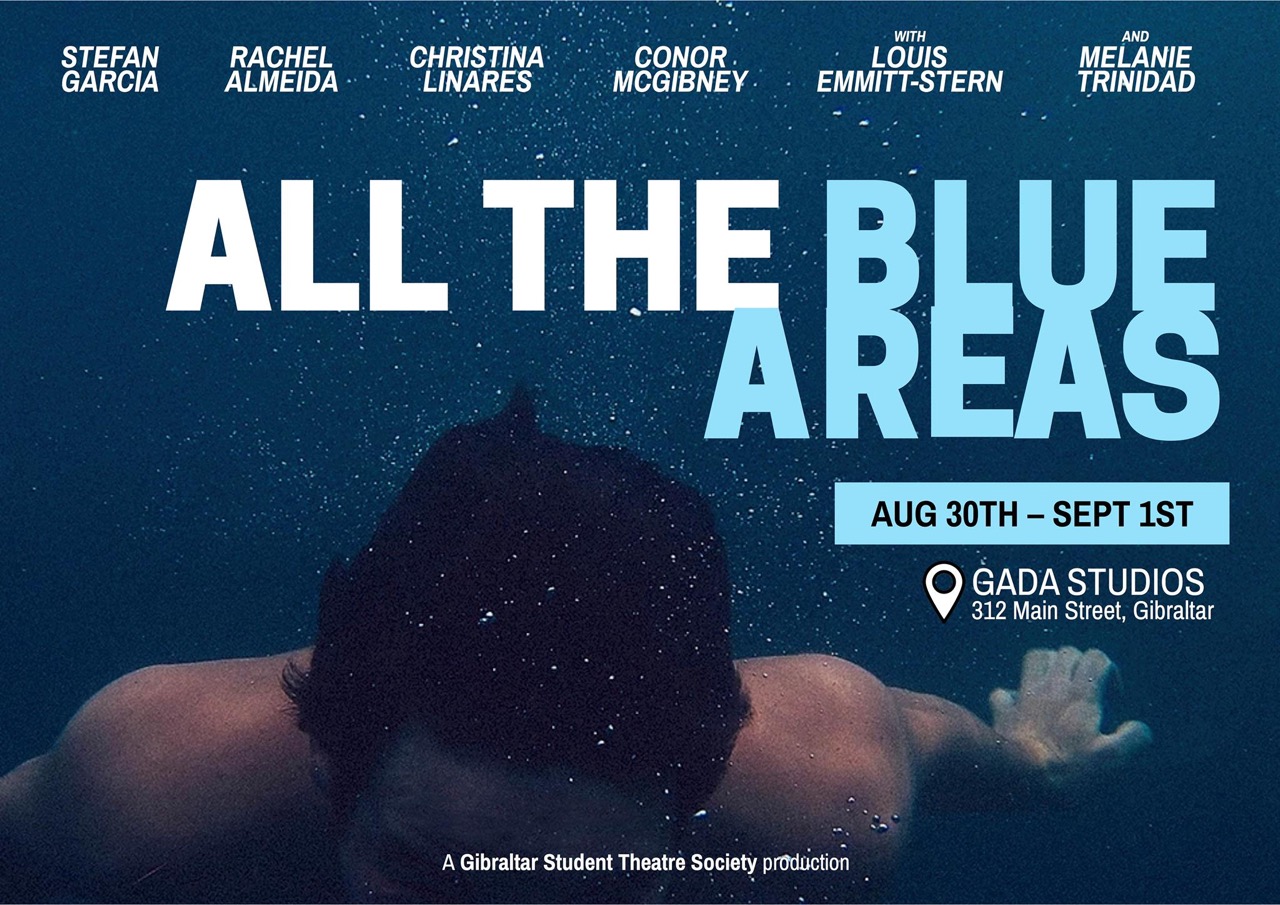Aug 31 - ‘All The Blue Areas’ - Play Review
 By Julian Felice
By Julian Felice
It is always very gratifying to see young people show the initiative – and, of course, the courage – to stage theatre productions. From Teen (later Team) productions in the 1990’s right through the likes of Dramatis Personae and the Student Actors Society, Gibraltar has a rich tradition of students putting on performances, something that should always be commended.
The Gibraltar Student Theatre Society – who make their debut this week with their production of All The Blue Areas at GADA Studios – are the latest chapter in this tradition, led firmly by all-rounder Louis Emmitt-Stern. Louis’ work in playwriting has already started to attract the attention of well-known companies such as the Royal Court Theatre and PaperCut Theatre Company, and All The Blue Areas is his first attempt at staging his own work.
Focusing on a group of disparate individuals who run a gay porn website from a council (not counsel!) flat in Harlseden, All The Blue Areas is a challenging gritty drama that, while maybe not fully delivering in its promise of being an explosive exploration of issues concerning toxic gay masculinity, is nonetheless a skillfully constructed piece of work that features excellent dialogue, well-defined characters, and a strong understanding of what works on stage.
The first act is particularly successful, with Louis adeptly changing focus among all the characters in a manner that engages the audience from the start of the performance. The language and subject matter are not for the faint-hearted, but Louis succeeds in making this relevant and avoiding the ‘shock-for-the-sake-of-it’ quality that can sometimes affect the In Yer Face genre of which this play forms a part. Indeed, there are many echoes of Jez Butterworth in the play, showing how well Louis has incorporated much of the work to which he has been exposed.
The play’s more shocking events, however, are not fully justified earlier on in the piece, and the short second half could perhaps be lengthened by developing these storylines further as the play does seem to wash its hands of them a bit too conveniently quickly. With Louis now moving on to a play-writing course at university, however, one cannot help but expect his obvious potential as a writer will be fully exploited, and we can all look forward to some very exciting work from this young man.
Louis also directs the play and makes the correct decision to perform it at GADA Studios, an intimate space that places the actors close to the (pleasingly full) audience. He also stages it in a traverse layout, allowing for many different points of view depending on where one is sitting. This makes the play very engaging and places the audience almost within the claustrophobic setting of this small, untidy living room. Setting is also changed very quickly and easily through the use of clothes racks and benches, showing a dynamic way of handling transitions. There were a few moments when some of the angles were a bit clumsy (one should avoid parallel lines on a traverse stage and block through diagonals) and the sound effects were far too loud (this may have been a deliberate Yerma-inspired decision, but I did not feel it worked within the naturalistic nature of the piece), but there was once again little doubt of Louis’ ability as a director, with this best evidenced in the performances he was able to draw out of his actors (more on that later). Creativity and vision are hugely important for a director, and Louis has these in bounds.
And, of course, Louis also formed part of the cast, playing the role of Andy. He clearly enjoyed performing this thoroughly unpleasant individual, with Louis delivering the character’s bleak cynicism to great effect. Andy has most of the funniest lines in the play, and Louis demonstrated a good sense of comic timing, coupled with a strong command of voice and gesture. I would have expected such a character, though, to be more expressive with his face, particularly in the more spontaneous moments towards the end of the play, and Louis should try to avoid stooping – his height is a huge advantage on stage and one that should be taken advantage of as much as possible.
Surrounding him was a cast of talented young actors who, through Louis’ direction, showed full commitment to the play’s objectives. Rachel Almeida (Gaby) is always very watchable, a confident and technically compelling actress who conveyed much of her character’s pathos. She had the difficult task of opening the play and handled its first lengthy monologue, a responsibility she seemed to be aware of, delivering it in an engaging manner throughout. Rachel fell a bit short of hitting some of her character’s emotional peaks, but this was a thoroughly convincing performance of one of the play’s more likeable characters.
Conor McGibney, who played the role of Fin, also performed with confidence and intensity in what was a tricky role. Despite his young age, Conor is already an experienced actor, and his first year at university has clearly had an impact, as evidenced by this mature portrayal. It is a shame that his character fades a bit towards the second half of the play, and Fin’s breakdown lacked some of the intensity we had seen earlier, but Conor succeeded in creating this murky individual about whom we wish to know more.
The role of the sensitive Jan was played by the likeable Stefan Garcia, who, again, performed with a confidence that belies his tender years. Stefan makes very good use of his voice, and he uses his body effectively in showing some of the emotional nuances of the character. He also has a very reliable awareness on stage. He seemed a bit less secure in the second half when the character starts to unravel, but as he increasingly finds his feet in the role (I watched the production on its opening night) I am sure we will see more of that forceful broodiness that Stefan does so well.
The play also marked a much welcome and long overdue return to the local stage for Christina Linares who, despite perhaps looking a bit too young for this role, played the cold and clinical Paige with success. Christina has excellent diction and is patient with pause – an often difficult skill for young performers to master – and, in many ways, she was the perfect counterfoil to all the other actors around her, grounding the play in her business-like approach to the turmoil unraveling in the house she very much manages. I would have liked to have seen her be more assertive, particularly with Gaby, but this was just another reminder of what a talented performer Christina is and how comfortable she always seems on stage.
Finally, Melanie Trinidad completed the cast as Clare. This was a difficult and daring role that Melanie handled with emotion and boldness, taking careful control not to let the performance run away from her in one of the play’s most harrowing scenes. Young actors can sometimes be afraid of making themselves vulnerable on stage, but there seemed little of this in Melanie. This was intelligent casting by the director, who was not let down by any of his actors.
Seldom is provocative and controversial work staged in Gibraltar, much less by students, so it was very satisfying to see such a young team handle a work of such depth and complexity (and ably supported by their backstage and Front of House teams). These young people are doing exactly what they should be doing at this stage of their lives: staging their own plays and making the most of any opportunities that come their way. Yes, their youthful ambition will lead them to making the occasional mistake, but this will be massively outbalanced by their successes, among which All The Blue Areas will clearly count. As long as they maintain this commitment to drama, a willingness to learn through the work of others, and their youthful vitality, then these individuals will go on to become the future of Gibraltarian drama, a future that is, clearly, in very good hands.

{fcomment}
Latest News
- Spring Festival 2025 Short Story Winners
- Chamber Of Commerce Statement On Public Sector Pay Award
- Final Call For Questions On Treaty Via Official Email Channel
- Therapeutic Counselling Services At HM Prison
- Ministry Of Equality’s Pride Initiative: ‘Closets Are For Clothes, Not People’ Now On Display
- Autumn Bookmark Competition 2025
- Dolphins Youth Club Hosts Successful Annual Summer Community BBQ
- Unite The Union: Pride Is Every Day – Equality Is A Right, Not A Trend
- Book Launch Of 'Me Acuerdo: Memories Of Gibraltar’s Old Town'
- Acquarius Selected As A Finalist At STEP Awards In London



